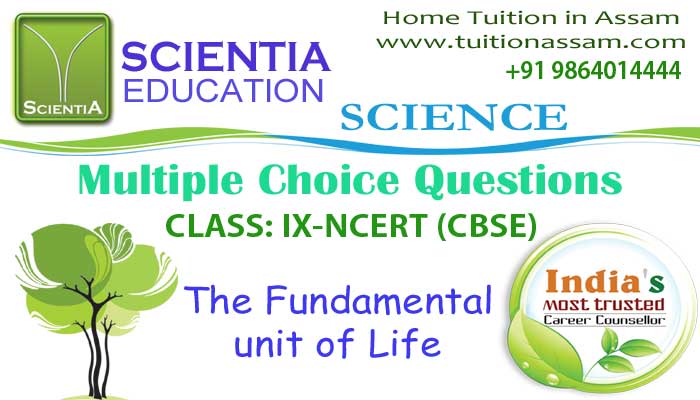
CLASS: IX NCERT (CBSE)
BIOLOGY
The Fundamental unit of Life
Multiple Choice Questions
Question 1: The approximate number of cells in a normal human body is ____.
1. 10
2. 100
3. 1014
4. 10144
Answer: 3
Question 2: Tick the wrong choice: Plasma or cell membrane is ____.
1. outer covering of each cell
2. made of lipids and proteins
3. superheated gases
4. a mechanical barrier for the protection of inner cell contents
Answer: 3
Question 3: Mitochondria are also called _____.
1. suicide bags
2. digestive bags
3. protein synthesizers
4. power house of the cell
Answer: 4
Question 4: ATP stands for _____.
1. Adenosine triphosphate
2. Adenosine diphosphate
3. Advanced tactical plane
4. Adenosine terphosphorus
Answer: 1
Question 5: The correct order of the phases in mitosis are ____.
1. prophase, telophase, metaphase, anaphase
2. prophase, metaphase, anaphase, telophase
3. telophase, anaphase, metaphase, prophase
4. metaphase, telophase, anaphase, prophase
Answer: 2
Question 6: The resting or non-dividing stage between two successive mitotic divisions is called ____.
1. metaphase
2. telophase
3. interphase
4. prophase
Answer: 3
Question 7: Centrosomes are present in _____.
1. animal cells only
2. plant cells only
3. in both plant cells and animal cells
4. in neither plant cells nor animal cells
Answer: 1
Question 8: Vacuoles (in plant cells) _____.
1. produce energy for the cell
2. synthesize proteins
3. defend the cell
4. provide turgidity and rigidity to plant cells
Answer: 4
Question 9: Organelle not present in animal cells is _____.
1. plastid
2. centrosome
3. nucleus
4. mitochondria
Answer: 1
Question 10: The excretory organelle of the cell is also called ____.
1. ribosome
2. golgi apparatus
3. peroxisomes
4. centrosomes
Answer: 2
Question 11: The power house of a cell is ____.
1. chloroplast
2. mitochondrion
3. nucleolus
4. vacuole
Answer: 2
Question 12: The ‘Scavengers’ or ‘Digestive bags’ of a cell are ____.
1. chromosomes
2. centrosomes
3. lysosomes
4. ribosomes
Answer: 3
Question 13: The site of oxidation in a cell is the _____.
1. mitochondrion
2. endoplasmic reticulum
3. golgi apparatus
4. ribosome
Answer: 1
Question 14: Lysosomes are reservoirs of ____.
1. fat
2. secretory glycoproteins
3. RNA
4. hydrolytic enzymes
Answer: 4
Question 15: The network of endoplasmic reticulum is present in the ____.
1. nucleus
2. chromosome
3. cytoplasm
4. golgi apparatus
Answer: 3
Question 16: Centrioles are associated with ____________.
1. digestion
2. respiration
3. reproduction
4. cell division
Answer: 4
Question 17: A cell has 4 chromosomes. After mitotic cell division the number of chromosomes in the daughter cell would be __________.
1. 8
2. 4
3. 16
4. 32
Answer: 2
Question 18: Synapsis occurs during __________.
1. Mitosis
2. Meiosis
3. Amitosis
4. None of the above
Answer: 2
Question 19: Division of cytoplasm is known as ______________.
1. Karyokinesis
2. Plasmolysis
3. Cytokinesis
4. None of the above
Answer: 3
Question 20: The point where crossing over of chromatids takes place is ___.
1. chiasma
2. kinetochore
3. centromere
4. chromomere
Answer: 1
Question 21: The largest animal cell is ____.
1. ostrich egg
2. amoeba
3. red blood corpuscle
4. human sperm
Answer: 1
Question 22: The organism that is an exception to the cell theory is ____.
1. virus
2. bacteria
3. amoeba
4. paramecium
Answer: 1
Question 23: The largest cell in the human body is ___________.
1. nerve cell
2. muscle cell
3. liver cell
4. kidney cell
Answer: 1
Question 24: Double membrane is absent in ______________.
1. lysosomes
2. chloroplast
3. nucleus
4. mitochondria
Answer: 4
Question 25: Organisms lacking nucleus and membrane bound organelle are _________.
1. diploids
2. prokaryotes
3. haploids
4. eukaryotes
Answer: 2













